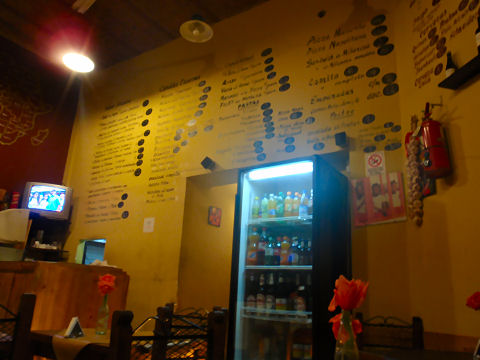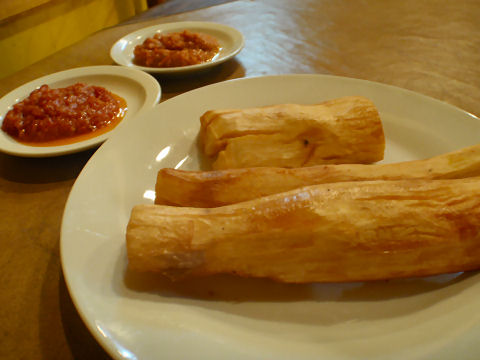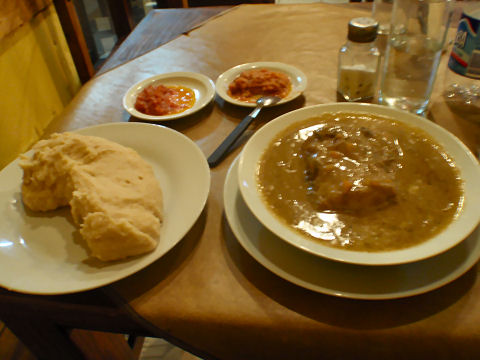“Reminds me of my safari in Africa. Somebody forgot the corkscrew and for several days we had to live on nothing but food and water.”
– W.C. Fields
Buenos Aires – Over the past few months I’ve been hearing about “an African restaurant” that opened up over by Parque Centenario in Villa Crespo. No one seemed overly enthused, other than about the fact that it was simply something different. And, it is different for BsAs – after all, outside of a couple of Moroccan restaurants, the continent of Africa is woefully under-represented here. Then again, it usually is in most other continents. Still, three restaurants is more than, say, for the continent of Australia, which to the best of my knowledge has no presence here, gastronomically speaking. So when a local, online acquaintance suggested meeting there one eve last week, I was game, and off I trooped, on the 92 bus, to El Buen Sabor, Camargo 296, 4584-8800. My acquaintance didn’t show (a back and forth disagreement about who was where, all I know is, I had dinner there, she didn’t), but I sat down to an interesting and tasty meal.

First of all, it’s a hole-in-the-wall. Not disparagingly, it’s clean and brightly lit. The space is a cheery yellow with the menu plastered across the wall (also a paper version available), with a listing of African specialties along with “traditional dishes” – which seems to mean milanesas, pastas, and sandwiches that could be found at any local porteño cafe – even their website only currently lists the latter (there’s a non-working link to view the African menu). I’m not overly versed in the cuisines of Africa myself, though my sense is that most of the dishes are probably from the west coast and perhaps on down around the coast to Nigeria. The staff seem to be four guys rattling away in heavily accented French – none of them speak much Spanish, nor English, and ordering, for the most part, is done by pointing at something on the menu (which is in Spanish and French), or by giving a go at the French name of the dish. They’ve got the porteño style of service down pat that, two of the guys never left staring at the computer screen, the waiter, who cheerfully greeted each person on arrival and delivered a menu, and served the food, spent the rest of the time back in the kitchen with the chef/cook, who was the one who came out and took the orders. So most of the time, no one was paying any attention.

The one thing that would have been nice, with, perhaps, a waiter who spoke enough Spanish to let me (or anyone else) know that the portions are huge. This appetizer of fried yucca root, though way too much starch for the whole dinner, was enough to be the whole one. The two sauces, delicious – a very smooth and almost fruity tomato sauce, and a fiery hot chili sauce. They seemed to work best in combination, a little of each with each bite.

And then the main course arrived – a big, steaming bowl of a fairly thin, vaguely peanut flavored vegetable broth with a large piece of corvina, or grouper, mucking about in it – bones, fins and skin – thankfully gutted and scaled. It was good – not wow by any stretch – just good home cooking – and, not at all what I imagined in a dish of fish with peanut sauce. The foufou on the side, a massive portion of completely unseasoned semolina mush, about the size of two large baking potatoes, worked well when doused in the soup, with a bite of fish, and perhaps a bit of the hot sauce. The two other tables of people dining inside while I was there all ordered from the African menu as well, and bowls of soupy sauces with meat sticking out of them of one sort or another seemed the order of the day. There were two guys having wine and smoking outside at a table who seemed completely stunned that there wasn’t a tabla of fiambres (coldcuts and cheeses) available for them to enjoy with their wine – and quickly finished off their wine and left, a bit… ticked off… that the food wasn’t Argentine cafe style. Jeez guys, read the big sign that says “Comida Africana”… ya know?
So hmm, would I go back? The food was decent, if a touch bland, mostly of interest simply because, as noted by the folks who told me about it in the first place, it’s different. It’s inexpensive – both plates plus a bottle of water ran me only 37 pesos, or about ten dollars. Yeah, I suppose I would, just for a cheap and interesting meal – but I wouldn’t make a mad rush to get back there.
Dan, sounds like west african food, it’s all about the VERY hot sauce. Tom and I lived in Ghana for 2 years, Nancy
Well then, certainly on that account, they hit the nail on the head! It’s unusual that I find a hot sauce to be too much for me, but this one was just a touch over the line, though toned down with the sweet tomato sauce it was great!
Tom here. The foufou is normally made from pounding a casaba plant until it is the consistency of raw white bread dough. Delicious with a very hot sauce with a piece of meat or fish in it…..eaten by tearing off a piece of the foufou and dipping it in the sauce.
Thanks for the info – I did a little digging – and at least according to the couple of African cookbooks I’ve got here, foufou is a catch-all term meaning, essentially, mush – cassava (manioc, yucca, tapioca root) is one of the most commonly used starches, being the main staple of much of West African cuisine, but foufou is also made from sweet potato, plantain, rice, corn, and other grains. It seems the further you get from the coastal area in the far west, the more likely it is to be something else, probably, just based on intuition, because the staple grain is different (i.e., in South Africa it seems to almost all be corn-based).
In terms of the food at El Buen Sabor – since I didn’t ask the guys where they were from, it’s hard to say if the use of semolina for their foufou is their tradition, or because they found it easier to get semolina than cassava flour here (which is available, but generally requires a trip to either Barrio Chino or out to the Bolivian markets in Liniers). However, the majority of the new wave of African immigration here, at least based on a couple of news reports, has been from Nigeria and Cameroon, and perhaps it’s as simple as that difference – though, English is more likely to be spoken in those two countries than French. There’s also a population from Senegal, Sierra Leone, and Liberia that’s growing, again, the latter two English is more common, so perhaps we can guess that these guys are from Senegal… or maybe somewhere else entirely. Easiest, of course, would be simply to ask them – and had one of them paid attention to the dining room long enough to have a conversation, I might have just done so.